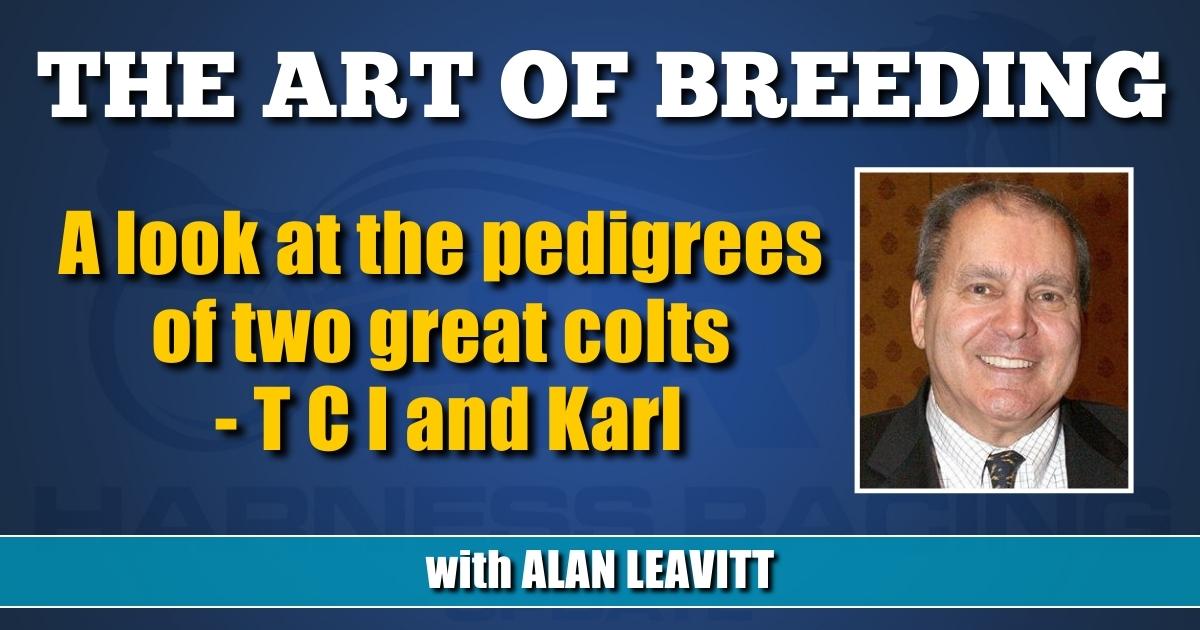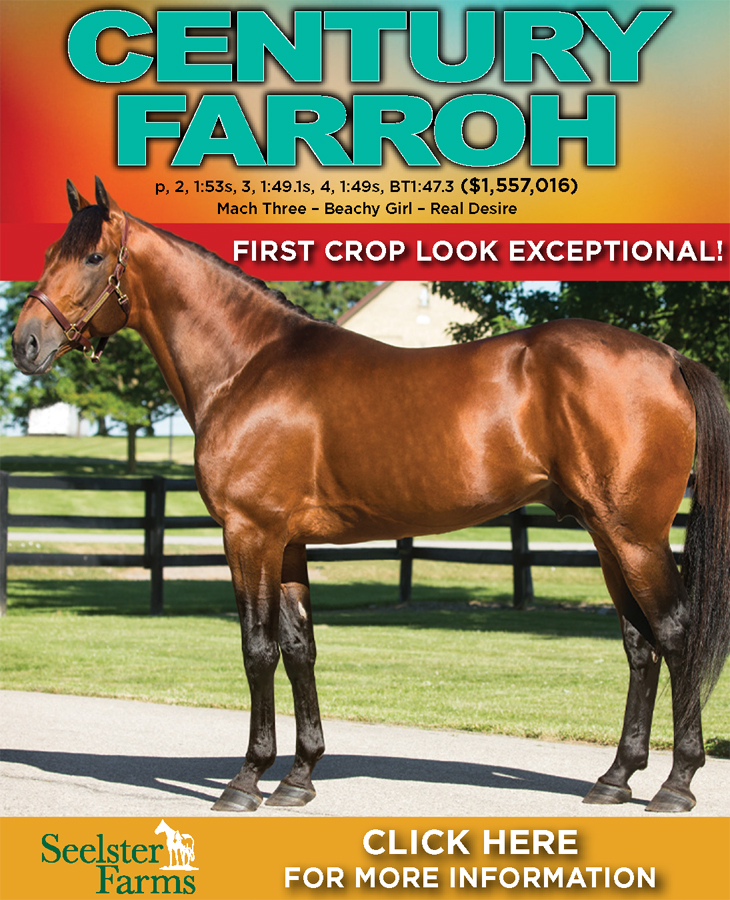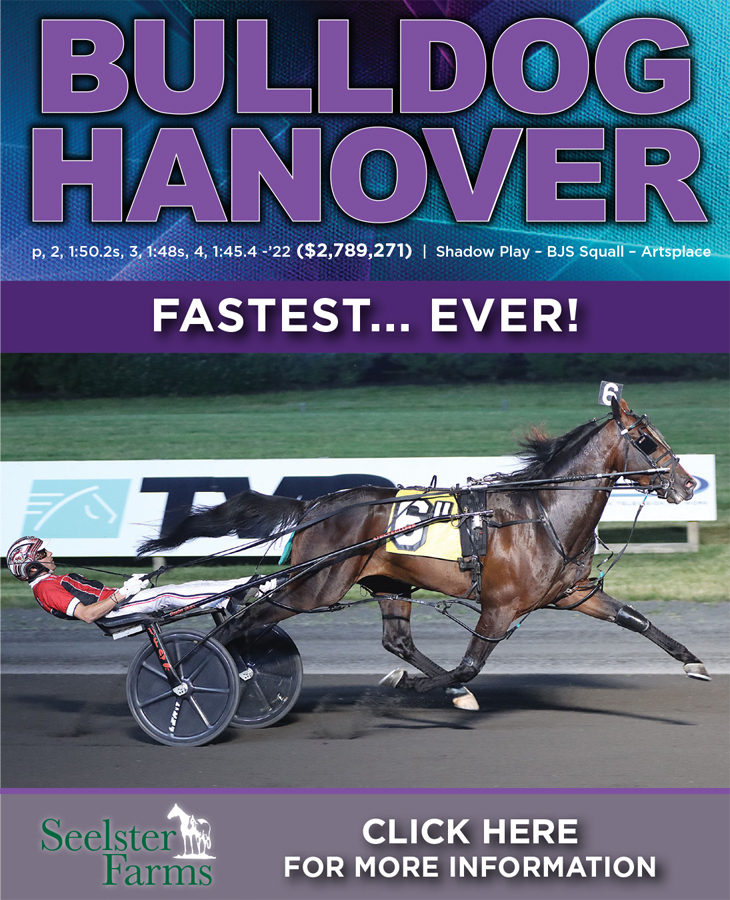

A look at the pedigrees of two great colts – T C I and Karl
by Alan Leavitt
There are two outstanding 2-year-old trotting colts this season, which bodes well for the future of the breed when they enter the stud.
They are, in alphabetical order: Karl 2, 1:51.2 ($347,260), by Tactical Landing and out of Avalicious, by RC Royalty; and T C I 2, 1:51.4 ($1,081,370), by Cantab Hall and out of Nicole’s Promise, by Dream Vacation.
The only time these two killers rumbled together, it took the photo finish cameras to decide whose nose got there first. I admit to being a sometime-sentimentalist, but I was pulling for a dead heat.
Both of these colts have identical pedigrees in the sense that the only double cross anywhere is in the fourth generation. In T C I’s case he is 4 by 4 to Valley Victory, and Karl is 4 by 4 to American Winner.
In technical terms this makes both colts Line Bred, one to Valley Victory, the other to American Winner. Just as a reminder, when the sum of the generations in which the same name appears twice is 6 or less, you have Inbreeding.
When the sum of the generations in which the same name appears twice is 7 or 8, that’s Line Breeding: Any number higher than 8 is an outcross.
On a numerical basis, by the time you get to the fourth generation, its weight is 6 ¼ per cent. So, a double cross is only 12.5 per cent. But I believe that a stallion with a powerful Genotype, or genetic profile, his affect for exceeds his numerical standing.
That is especially true with Valley Victory. He lifted the trotting breed to a new level. It’s notable that there was a synergy between him and the mare Crown Dream.
With one mating they produced the Hambletonian winner Victory Dream. With another, the resulting progeny was the successful racehorse and sire Dream Vacation 4, 1:52 ($616,272).
As for the definition of the word “synergy,” think 2 + 3 = 9.
It’s a neat word, which the sport’s great owner Serge Godin actually took for his previous stable name.
Back to American Winner, he himself won the Hambletonian and he sired Yankee Blondie, the dam of the great present-day sire, Muscle Hill. He, in turn, begot Tactical Landing, who sired this year’s Hambletonian champion, Tactical Approach.
Here, a short, personal digression.
The definitive relationship of this kid’s life was my 50 plus years with Howard Beissinger. He was “The Boss” to me, from my years of riding with him on the training track in Florida. For credentials, Beissinger not only trained but drove three Hambletonian winners, Lindy’s Pride, Speedy Crown and Speedy Somolli.
The latter two each sired three Hambletonian winners, and thereby changed the trotting breed for the better for generations to come. For the record, this kid stood those horses throughout their stud careers.
Actually, my relationship with Speedy Somolli started when I syndicated him before his 3-year-old season. As one benefit of that deal, I was the one to whom the winner’s trophy was presented on the track at DuQuoin.
Which brings me to Super Juan, who was also trained by The Boss. In his day a race called the Beacon Course preceded the big dance at The Meadowland’s. It was raced in eliminations and a final on the same night.
Beissinger warmed up Super Juan three heats for the Beacon Course. He then finished fourth in the elimination heat and then won the final. And then he kept Super Juan hot in The Big M’s race paddock for another hour, and then worked him a mile in 2:07.
Today, that kind of horsemanship would bring down the authorities and PETA on your head, but it made Super Juan so sharp he won a heat of the Hambletonian and finished second in the final. He never was that good again, but it didn’t matter; he had already written his name indelibly in the history of our great sport.
Now to a serious subject that demands the attention of every horseperson in Kentucky. We are one of the few harness racing jurisdictions in North America which doesn’t have its own, protected Sire Stakes program.
This because the committee that controls the allocation of money to a potential sire stake is controlled by someone who resists the concept of such a program.
I am unable to elicit any reason, let alone a good reason, for this negativity. Obviously, a protected sire stakes here would be a boon to every breeder, owner, trainer, driver, even down to the grooms who rub our racehorses.
I’ve done all I can. Perhaps someone more persuasive can advance the argument for this beneficial concept, and reason will prevail.














